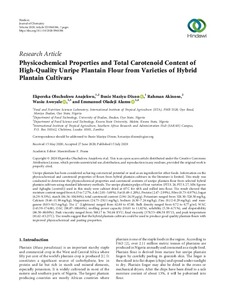| dc.contributor.author | Anajekwu, E.O. |
| dc.contributor.author | Maziya-Dixon, B. |
| dc.contributor.author | Akinoso, R. |
| dc.contributor.author | Awoyale, W. |
| dc.contributor.author | Alamu, E.O. |
| dc.date.accessioned | 2020-11-06T12:04:28Z |
| dc.date.available | 2020-11-06T12:04:28Z |
| dc.date.issued | 2020 |
| dc.identifier.citation | Anajekwu, E.O., Maziya-Dixon, B., Akinoso, R., Awoyale, W. & Alamu, E.O. (2020). Physicochemical properties and total carotenoid content of high-quality unripe plantain flour from varieties of hybrid plantain cultivars. Journal of Chemistry, 2020: 5960346, 1-7. |
| dc.identifier.issn | 2090-9063 |
| dc.identifier.uri | https://hdl.handle.net/20.500.12478/6984 |
| dc.description.abstract | Unripe plantain has been considered as having commercial potential or used as an ingredient for other foods. Information on the physicochemical and carotenoid properties of flours from hybrid plantain cultivars in the literature is limited. This study was conducted to determine the physicochemical properties and carotenoid contents of unripe plantain flour from selected hybrid plantain cultivars using standard laboratory methods. The unripe plantain pulps of four varieties (PITA 26, PITA 27, Mbi Egome and Agbagba (control)) used in this study were cabinet dried at 65°C for 48 h and milled into flour. The result showed that moisture content ranged from 6.15 to 7.27%, Ash (2.01–3.69%), Fat (0.49–1.20%), Protein (2.47–2.99%), Fibre (0.73–0.97%), Sugar (6.29–9.33%), starch (84.34–104.96%), total carotenoid content (2.96–24.19 µg/g). Potassium ranged from 328.30–528.50 mg/kg, Calcium (9.46–11.98 mg/kg), Magnesium (24.73–29.11 mg/kg), Sodium (6.30–7.24 mg/kg), Zinc (0.12–0.29 mg/kg), and manganese (0.03–0.15 mg/kg). The (Lightness) ranged from 62.88 to 67.00. Bulk density ranged from 0.72 to 0.77 g/ml, WAC (143.59–174.08), OAC (98.07–100.66%), swelling power capacity (10.63 to 11.82%), solubility (5.58–6.71%), and dispersibility (86.50–88.00%). Peak viscosity ranged from 568.17 to 761.64 RVU, final viscosity (378.53–496.58 RVU), and peak temperature (81.62–83.23°C). The results suggest that the hybrid plantain cultivars could be used to produce good quality plantain flours with improved physicochemical and pasting properties. |
| dc.format.extent | 1-7 |
| dc.language.iso | en |
| dc.subject | Plantains |
| dc.subject | Physicochemical Properties |
| dc.subject | Carotenoids |
| dc.subject | Cultivars |
| dc.subject | Nigeria |
| dc.subject | Breeding |
| dc.subject | Flours |
| dc.title | Physicochemical properties and total carotenoid content of high-quality unripe plantain flour from varieties of hybrid plantain cultivars |
| dc.type | Journal Article |
| cg.contributor.crp | Agriculture for Nutrition and Health |
| cg.contributor.crp | Maize |
| cg.contributor.crp | Roots, Tubers and Bananas |
| cg.contributor.affiliation | International Institute of Tropical Agriculture |
| cg.contributor.affiliation | University of Ibadan |
| cg.contributor.affiliation | Kwara State University |
| cg.coverage.region | Africa |
| cg.coverage.region | West Africa |
| cg.coverage.country | Nigeria |
| cg.coverage.hub | Southern Africa Hub |
| cg.coverage.hub | Headquarters and Western Africa Hub |
| cg.researchtheme | Nutrition and Human Health |
| cg.identifier.bibtexciteid | ANAJEKWU:2020 |
| cg.isijournal | ISI Journal |
| cg.authorship.types | CGIAR and developing country institute |
| cg.iitasubject | Natural Resource Management |
| cg.iitasubject | Nutrition |
| cg.iitasubject | Plant Breeding |
| cg.iitasubject | Plantain |
| cg.iitasubject | Value Chains |
| cg.journal | Journal of Chemistry |
| cg.notes | Published online: 15 Jul 2020 |
| cg.accessibilitystatus | Open Access |
| cg.reviewstatus | Peer Review |
| cg.usagerightslicense | Creative Commons Attribution 4.0 (CC BY 0.0) |
| cg.targetaudience | Scientists |
| cg.identifier.doi | https://dx.doi.org/10.1155/2020/5960346 |
| cg.iitaauthor.identifier | Busie Maziya-Dixon: 0000-0003-2014-2201 |
| cg.iitaauthor.identifier | Wasiu Awoyale: 0000-0002-3635-1414 |
| cg.iitaauthor.identifier | Alamu Emmanuel Oladeji: 0000-0001-6263-1359 |
| cg.futureupdate.required | No |

